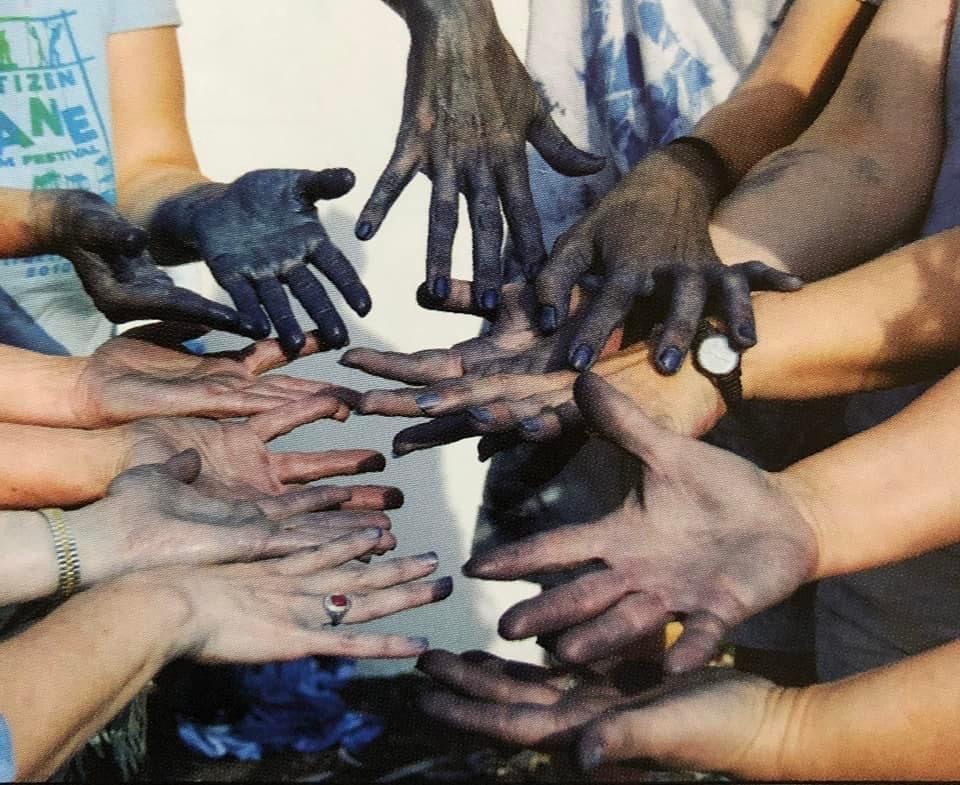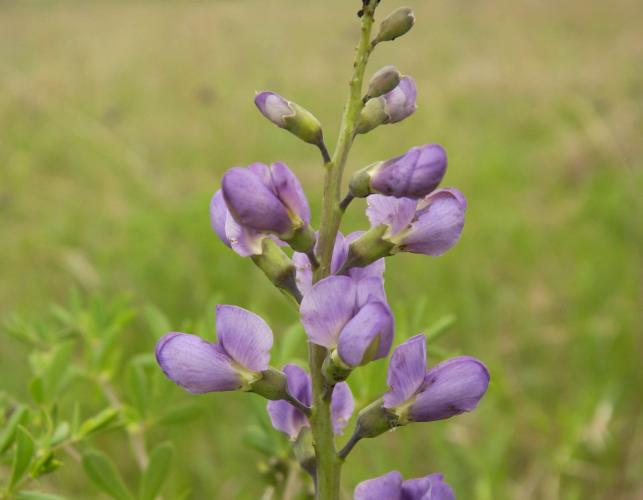
Once upon a time I had an indigo dye pot: a ten gallon bucket in the shed under the walnut trees in my back yard. It was the star of any crafting party I held. Sometimes we were overdyeing a yellow and then a quick dip would pop a green color. I remember one afternoon where one table was dyeing with red madder, another was carding wool for spinning and a circle under the beechnut tree had gathered to spin. Then there was my indigo pot with its pungent smell and colorful drying racks.
I remember visiting a historical Roman encampment in Mississippi. The reenactors had a number of permanent installations, including two dye hearths for their big iron kettles, fires lit underneath them to keep the dye hot and raised to protect the workers’ backs. That day they were dyeing long lengths of silk for clothing, both white and already dyed red fabrics. When something is removed from the indigo dye pot it comes out green and then as the air interacts with the material, the dye turns blue. It was so thrilling to watch happen as the women stretched silk along the wooden fences surrounding their work area. The blue and deep purple fabric was set against a background of bright green grass, fluffy clouds in the blue sky and red-armored soldiers practicing on the field.
 True indigo or Indigofera tinctoria can be grown in Missouri and its cousin, Blue False Indigo, is a native plant. Blue False Indigo does not contain enough pigment to use as a dye so just enjoy it for its flowers and the interesting seedpods it produces. You can purchase the seeds and grow your own True Indigo plants, but I chose to use pre-reduced indigo crystals, available from a number of online resources.
True indigo or Indigofera tinctoria can be grown in Missouri and its cousin, Blue False Indigo, is a native plant. Blue False Indigo does not contain enough pigment to use as a dye so just enjoy it for its flowers and the interesting seedpods it produces. You can purchase the seeds and grow your own True Indigo plants, but I chose to use pre-reduced indigo crystals, available from a number of online resources.
For a real visual treat, check out the book “Indigo: The Color That Changed the World.” Author Catherine Legrand writes of indigo’s history in Europe, Japan, China, Loas, Vietnam, India, Africa and Central America with vivid contemporary images of people dressed in blues and vats in use today. This book contains many personal stories of dyers following traditional paths. You will enjoy examining batiks and embroideries as well as whole cloth dye projects. I particularly enjoy examining the details that Legrand captured with her camera.
Join author Catherine E. McKinley as she journeys the ancient trade routes of West Africa in “Indigo: In search of the Color That Seduced the World.” McKinley travelled to West Africa in 1999 to visit historic sites, and she visited and learned from indigo dyers and printers. She traveled through nine West African countries during this 4-year journey and writes of her experiences, the colors she sees and the odors of the dye pots. We meet women with blue hands and families working together. Share in McKinley’s appreciation of the variety of patterns and cultural use of types of cloth.
Have you read enough to be interested in setting up your own dye pots? Before you dive in, and no pun intended as I frequently finish a dye session blue to my elbows, you may wish to first connect with local dyers. The Columbia Weavers and Spinners Guild is a valuable local resource for connecting with enthusiasts of all of the fiber arts, including dyeing. Another Columbia resource for dyes and advice is the Hillcreek Yarn Shoppe. The above photo of blue hands is from one of their Blue Parties.
Another resource we have at the library is a small blue book titled “Indigo From Seed to Dye.” It was written by Dorothy Miller whose indigo journey started in the 1950s while studying in Japan. In the ’70s, Miller wrote a pamphlet version of this book and sold it with a packet of indigo seeds. This is one of the only books I’ve read that clearly describes how to ferment the the leaves into paste and prepare the dye for the home dyer. And while advances in techniques has occurred since the book came out in 1985, you can replicate these traditional methods and successfully set up an indigo dye pot using this book.
Most of the indigo-blue items you see these days are dyed with synthetic dyes. The colors are durable and as versatile as natural indigo but doesn’t offer the same satisfaction to a dyer. If you wish, you can use your dye pot to over-dye your too-faded blue jeans, cotton shirts and wool skirts, or dye the yarn you want to knit into a cozy sweater. Or you can explore one of our many books such as “Step-By-Step Fabric Dyeing Project Book” by Susie Stokoe. Stokoe has several full-cloth projects for you to consider. She also introduces fabric manipulation such as marbling, pleating and tie-dyeing and suggests decorative items for your home using these techniques. Clear images help you understand the well-planned steps for each project.
Thank you for taking this short journey down memory lane with me! I’ve not taken up dyeing again and may not, with a reawakened interest in sewing and old machines and piecing quilts. Dyeing is a great hobby that adds beauty and satisfaction to your life and home, and I hope that someday I will meet you around the dye pots in someone else’s back yard.



